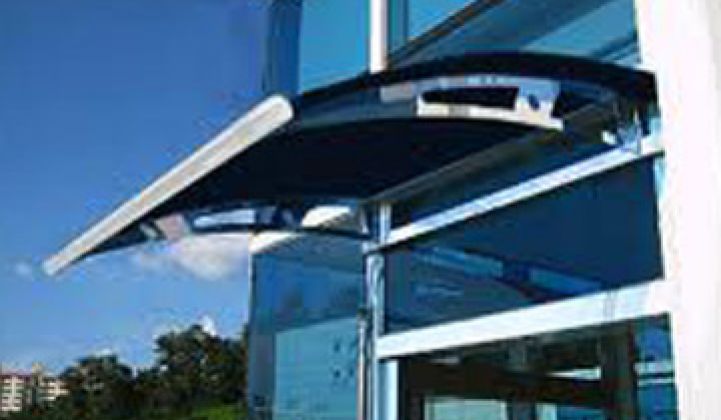If you want to install solar on the roof of your house, a reasonably sized solar system will run you in the neighborhood of $20,000 to $40,000. There are federal grants and state rebates but in any case, it's going to be a big ticket item, along the lines of a small car purchase. You can lease the system through a SolarCity, SunRun or Sungevity but in any case -- you are still making a big-time financial commitment.
It's that high initial cost and long-term commitment that keeps solar from going mainstream. It remains the domain of the early adopters. Additionally, not all homes have suitable roof space or orientation to accomodate a full-scale PV panel installation.
A few startups and established firms have tried to figure out how to make it easier for home-owners to buy and install photovoltaic panels.
Veranda Solar, now defunct, aspired to be the Apple Computer of solar -- providing small solar panels with an interesting form factor. Like Apple, Veranda was relatively expensive but unlike Apple, Veranda products weren't that well thought out or successful.
Armageddon Energy also goes after a different form-factor, the hexagonal SolarClover, and is trying to attack the installation aspect of residential. The premise is that if the installation is easier, other craftspeople like roofers and electricians can offer solar installations cheaper than those high-paid solar installers and reduce the minimum system size, to lower the entry price for PV systems. Armageddon received some funding from Tyco Electronics and has won awards from GE and others.. Michael Kanellos compared Armageddon to Ikea in simplicity and ease of assembly.
Ready Solar promised solar-in-a-box. The firm would pre-package and pre-wire solar panels and provide a head start on installation for solar installers. There was some minimal value to that service but not enough -- the company just sold its assets to Sun Edison for a small sum and is embroiled in a legal battle among its founders. Their solar-in-a-box was evidently a pine box.
In the real world, Andalay Solar, spawned from Akeena Solar (now Westinghouse), also packaged solar-in-a-box, providing simplified mounting equipment, preconfigured wiring and a microinverter -- again with the idea of making solar more available to different trades and even channeling the product through Lowe's, a home improvement chain. Our understanding is that the product is not exactly flying off the shelves.
***
Each of these approaches looks to confront the issue of making solar more accessible and easier to install and most have met their share of challenges.
Clarian has a different approach and might have found the answer to the riddle.
I interviewed, Chad Maglaque, the President of Clarian Power. He said, "Our product vision is not DIY (do it yourself)." He added "DIY is a feature -- its not our go-to-market strategy."
In most cases it will be a professional installer doing the work. Maglaque said, "We expect this to go through reseller channels."
"We're not looking to be on the rooftop," according to the CEO. The company's model is to package two or three panels for installation on a deck, patio, garden shed or awning on the premise that "everyone has some southern exposure" The two-panel system can an be installed by a handyman or contractor in about two hours including the "smart box."
Again, it's power-in-a-box but with a different tack. Unlike Armageddon or Veranda, Clarian uses standard panels - actually AC modules with integrated microiverters. Unlike Ready Solar or Westinghouse the panels plug directly into a home wall socket.
The trick for Clarian is their "SmartBox." It's a monitoring device that plugs into a standard outlet.
"The inverter solves the utility problem. The "SmartBox" solves the code problem -- you have to have circuit protection." Their smart box swaps out for the GFI (Ground Fault Interrupter), which is by code the first outlet after the panel. Everything else is downstream. There's existing wiring in your home that will support 1,400 watts bi-directionally
"What we're doing with the SmartBox is just monitoring the circuit - what we're doing is providing the plug and play. We're not a solar panel or microinverter manufacturer. And we're AC module and power source agnostic. As long as you give us 120 volt AC power." The SmartBox could support a small wind turbine or a back-up power unit.
Power produced by the solar panel(s) is consumed within the home. The system is limited to 1,000 watts with the solar panel getting permission from the smart box continuously to provide power.
Note that this system is an interconnected device -- there is still an interconnection agreement with the utility. But the CEO is looking to simplify the interconnection agreement and make it "the 1040EZ of interconnection." "There is no net metering, no price schedule, no export., he adds. Again the power is consumed entirely in the home.
The solar panels might not turn the electric meter backwards but they will slow it down. And according to the CEO, "Utilities really like this," adding, "We look like a conservation resource."
This lowers the entry price to solar according to the CEO. The MSRP for one Clarian panel is $899 for one panel with inverter and mounting hardware. The firm figures it works out to about $4.00 to 4.50 per watt installed. The CEO says that "We've put together a nice reseller package," that will allow the installer to make money.
Clarian is still small and early stage. The self-funded, 5-person firm is still in pre-production and is undergoing UL certification. A pilot program is expected in April.
Clarian also has a household battery back-up product intended to reside under your clothes dryer pedestal. And their smart box won the 2010 Consumer Innovation Award from GE as part of their Ecomagination Challenge last fall



